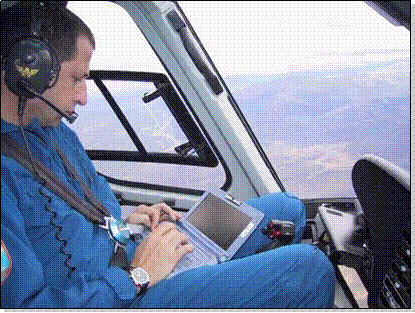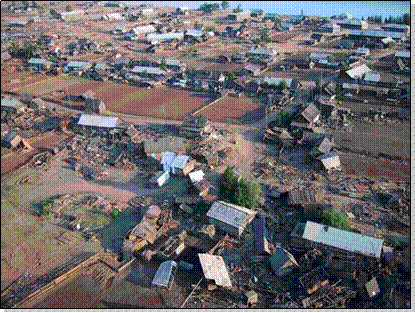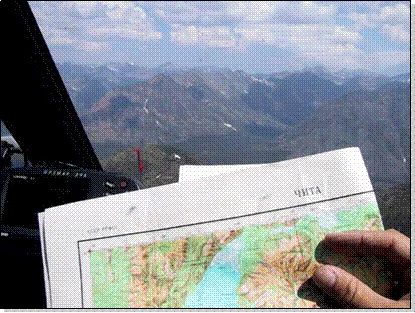
|
World Odyssey |
|
Deepest Siberia Friday 22 June
We've flown over enough trees in the last few days to reforest half of South America. Nothing but dense forest, streams and lakes for endless hours. There is still snow in the highlands, and except for the occasional logging road, we fly from airport to airport with barely a man-made object in between. To keep ourselves amused, we compete to spot animals or find the most interesting landscapes. The photo of Happy Face Tundra is a leading contender. The insects in this part of the world are huge, needing a significant fraction of a horsepower to fly, with at least that much energy left over for biting. During flight we see them streaking towards our heli like little missiles.
Before our trip, we heard reports about flooding in Siberia, but nothing could prepare us for what we saw in Lensk. The city is completely destroyed, with wooden houses tossed about like matchboxes. The river has receded, but the town is still empty.
From Lensk, we divert south to Lake Baikal, where we use of Russian maps to navigate through the mountains surrounding the lake. Thank god for GPS.
At the northern tip of Lake Baikal is tiny city called Nizheangarsk, or Nizhy for short. The only aircraft based in Nizhy's airport is a Russian MI-8 helicopter built in the 70's. Dimitry, the pilot of the MI-8 is waiting for us when we arrived, and within a few minutes has me strapped into his copilot's seat. I think he just wants to show me around, but to my surprise, Dimitry starts flipping dozens of switches as part of an incredibly complicated start up procedure. The helicopter comes to life with all kinds of strange lights and sounds. The only switch I dare touch turns on a little plastic fan in the corner of the cockpit. I need air.
On the fourth attempt, the engines finally start. Dimitry smiles and looks relaxed, so apparently ignition on the fourth try is normal. Slowly he lifts the huge beast into the air. The shaking is so violent that in my helicopter I would now be performing emergency procedures. Just as I am getting excited thinking that we might buzz around the lake a bit, Dimitry gently sets the helicopter back on the ground and shuts down the engines. Apparently, he has not obtained a flight permit for the day. But at least, he says defiantly, Moscow cannot prevent him from hovering.
I take Dimitry to see our heli. He sticks his head in the cockpit and frowns. I think maybe he doesn't care for all of the computer displays and high-tech gadgetry, but that isn't the problem. Dimitry reaches in his shirt pocket and takes out a little plastic card with a picture of the Madonna and baby Christ. This, he says, has been keeping him safe for over 20 years and he is amazed that we are flying without one. He hands me the card. I explain to him that I am Jewish, but the concept doesn't register. So out of politeness, I tape the card to our instrument panel where it stays until Dimitry disappears from view.
After Nizhy, we head to Magadan on the coast of the Okhotsk Sea. Only several hundred tourists come to this region every year, so any foreigner is a valuable source of revenue. A request for a one hour tour brings us a staff of four (an official driver, an official tour guide, an official translator and an official tour director, all requiring an official commission). Magadan was the Gulag capital of Russia. Lenin, then Stalin, had specialized in sending people on a one-way trip to Siberia. Hardly a trace of the camps remains, and only a modest monument to the millions who perished here sits on a hilltop outside the city. Yet in the main square of Magadan there stands to this day a huge statue of Lenin. Strange country.
It's now Friday and all airports east of Magadan are closed for the weekend. On Monday we'll head to the Wild East, and into some Siberian cities that even our navigator is afraid to visit. When seeing our proposed route, he points to the map and says: "Nyet, nyet. Bad city. Very bad city." We show him that we've run out of options to get to Alaska, and he rolls his eyes and says: "Crazy, very crazy." Russian navigators like to repeat things. But he does have a point. What kind of people choose to live in a place with temperatures of -60 degrees Celsius and without sunlight for half the year? Well, we're about to find out... |




|
Copyright Dari Shalon 2004 |